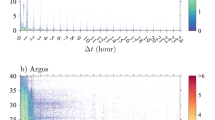Abstract
We conducted the drifter trajectory tracking experiment for two drifters in the East China Sea, in which the currents were detected by two multi-frequency HFSWRs using the Lagrange-tracking method. The tracking drifter trajectory shows good agreement with the GPS records by qualitative and quantitative analysis that indicates that drifter tracking by HFSWR is valid. In the 12-hour tracking for drifters P 1 and P 2, the average errors are 1.84 km, 1.73 km, and the maximum errors are 3.52 km and 3.12 km, respectively. The current measurement is evaluated by an acoustic Doppler current profilers (ADCP) in-situ observation, and it is the first multi-frequency HFSWR ocean surface monitoring experiment in China. In addition, the main aspects (HFSWR current measurement error, wind, and wave) influencing the tracking accuracy are discussed, and especially the wind factor’s impact is analyzed through the wind filed data.
Similar content being viewed by others
References
Barrick D E. Theory of HF and VHF propagation across the rough sea, Parts 1[J]. Radio Science, 1971, 6(5): 517–533.
Shearman E D R. Propagation and scattering in MF/HF ground wave radar[J]. Proc IEE, Part F, 1983, 130(7): 579–590.
Sevgi L, Ponsford A M, Chan H C. An integrated maritime surveillance system based on high-frequency surface wave radars, part I — theoretical background and numerical simulations[ J]. IEEE Antennas and Propagation Magazine, 2001, 43(4): 28–43.
Barnes L. HF Radar—The Key to Efficient Wide Area Maritime Surveillance[M]. Edition 3, London: ICG Publishing LTD, 1998: 115–118.
Barrick D E, Lipa B J. An evaluation of least-squares and closed-form dual-angle methods for CODAR surface-current applications[J]. IEEE Journal of Oceanic Engineering, 1986, 11(2): 322–326.
Essen H H, Gurgel K W, Schlick T. On the accuracy of current measurements by means of HF radar[J]. IEEE Journal of Oceanic Engineering, 2000, 25(4): 472–480.
Dzvonkovskaya A, Gurgel K W, Rohling H, et al. HF radar WERA application for ship detection and tracking [J]. European Journal of Navigation, 2009, 7(3): 18–25.
Wu Xiongbin, Yang Shaolin, Wu Shicai, et al. Ocean surface currents detection at the Eastern China Sea by HF surface wave radar[J]. Chinese Journal of Geophysics, 2003, 46(3): 340–346(Ch).
Yan S, Wu X, Chen Z. Remote sensing with TDMF radar: some preliminary results[J]. Progress in Electromagnetics Research Letters, 2010, 14: 79–90.
Wu Xiongbin, Li Lun, Shao Yixie, et al. Experimental determination of significant waveheight by OSMAR71: Comparison with results from buoy[J]. Wuhan University Journal of Nature Science, 2009, 14(6): 499–504.
Liu Lei, Wu Xiongbin, Chen Feng, et al. Algorithm for HF radar vector current measurements[J]. Journal of Oceanography, 2007, 63(1): 47–66.
Prandle D, Ryder D K. Measurement of surface currents in Liverpool Bay by high-frequency radar[J]. Nature, 1985, 315: 128–131.
Liu Y, Weisberg R H, Merz C R, et al. HF radar performance in a low energy environment: CODAR SeaSonde experience on the West Florida Shelf[J]. Journal of Atmospheric and Oceanic Technology, 2010, 27(10): 1689–1710.
Zhu Dayong, Li Li, Li Yan, et al. The Taiwan Strait South-West of the seasonal variation of surface currents by HF ground wave radar observation[J]. Chinese Science Bulletin, 2008, 53(11): 1339–1344(Ch).
Li Yan, Wu Xiangbai, Shao Hao. HF radar observation and analysis of resistance features at bottom bed of the shallow Taiwan Strait[R]. Xiamen: State Key Laboratory of Marine Enviormental Science, Xiamen University, 2009(Ch).
Ou Yang. Drift Model for Ship out of Control at Sea [D]. Dalian: Navigation College, Dalian Maritime University, 2008(Ch).
Hu Zhiwu, Zhang Qiurong, Gu Weiguo. Prediction technique of drifting course of disabled ships[J]. Marine Technology, 2007, 3: 18–21.
Liu Y, Weisberg, R H, Hu C, et al. Tracking the deepwater horizon oil spill: A modeling perspective[J]. EOS Transactions, American Geophysical Union, 2011, 92(6): 45–46.
Ullman, D S, O’Donnell J, Kohut J, et al. Trajectory prediction using HF radar surface currents: Monte Carlo simulations of prediction uncertainties[J]. Journal of Geophysical Research, 2005, 11: 1–14.
Abascal A J, Castanedo S, Medina R, et al. Application of HF radar currents to oil spill modeling[J]. Marine Pollution Bulletin, 2009, 58: 238–248.
Israelsson P H, Kim Young Do, Adams E E. A comparison of three Lagrange approaches for extending near field mixing calculations[J]. Environmental Modelling & Software, 2006, 21(12): 1631–1649.
Author information
Authors and Affiliations
Corresponding author
Additional information
Foundation item: Supported by the National High Technology Research and Development Program of China (863 Program) (2006AA09A303)
Biography: LI Lun, male, Ph.D. candidate, research direction: HF radio marine remote sensing.
Rights and permissions
About this article
Cite this article
Li, L., Wu, X., Yan, S. et al. Drifter trajectory tracking experiment and analysis with multi-frequency HFSWR in the East China Sea. Wuhan Univ. J. Nat. Sci. 16, 541–547 (2011). https://doi.org/10.1007/s11859-011-0794-z
Received:
Published:
Issue Date:
DOI: https://doi.org/10.1007/s11859-011-0794-z




